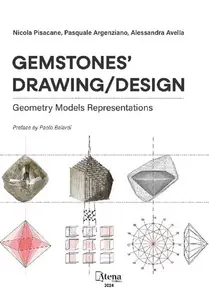
Free Download Gemstones’ Drawing/Design – Geometry. Models. Representations
by Nicola Pisacane, Pasquale Argenziano
English | 2024 | ISBN: 9786525827513 | 89 Pages | True PDF | 10.5 MB
The book is dedicated to the Drawing/Design of precious stones and has its roots in the educational field, as the authors state. It is divided into three chapters, accompanied by illustrations so eloquent as to return a sort of autonomous compendium.
In the first chapter – Crystals’ geometry in mineral and faceted gemstones – Nicola Pisacane goes far beyond the usual citation of the works of the great fifteenth-century treatises (from Piero della Francesca’s De quinque corporibus regularibus to Luca Pacioli’s Divina Proportione). He focuses his analyses on the later, less known but equally meaningful studies of Jean-Baptiste Romé de L’Isle, Abbot René Just Haüy, and Auguste Bravais, thus emphasizing with originality, as well as lucidity, the centrality of Geometry in the study of crystals and faceted gems.
In the second chapter – Crystallographic forms’ models, from tangible to digital – Alessandra Avella explores the concept of the model as a communicative artifact aimed at translating crystalline forms from the microscopic to the macroscopic scale, starting from the morphological crystallography of Jean-Baptiste Romé de L’Isle: an approach typical of historical pedagogical experiences (from the Pestalozzi method to the Montessori one, passing through the Bauhaus laboratory), but updated in a parametric key by prefiguring the compelling possibility of modeling ‘new’ crystals.
Finally, in the third chapter – The scientific representation of crystal polyhedra. Insights and methodological innovations (XVII-XX Centuries) – Pasquale Argenziano, highlights the synergistic interrelationships between the Parallel Projections for the study of crystals and faceted gemstones by René Just Haüy with the better-known ones by Gaspard Monge and William Farish, highlighting the theoretical acquisitions of Projective Geometry matured in the early Nineteenth Century in the French polytechnic milieu, and still other synergies with the theorization of crystallographic stereography pursued by Franz Ernst Neumann and William Hallowes Miller, extending the trigonometric foundations of cartography to the microscopic scale.
The book ends in the best possible way. Looking to the future, it opens the doors of research to JIM-Jewel Information Modeling, understood as a field of experimentation capable of combining parametric modeling with block-chain certification.










Leave a Reply
You must be logged in to post a comment.